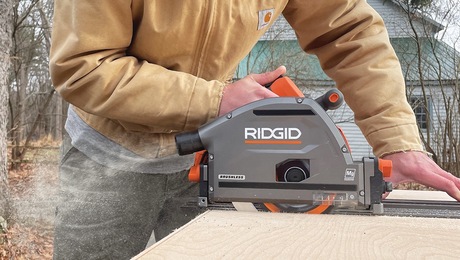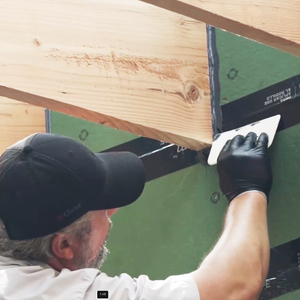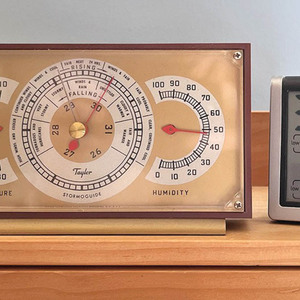Hey everybody. I’ve posted a similar question before but hey I’m anal and paranoid about my house. I put Tar paper over the plywood a couple of months ago and now I’m putting the vinyl siding up. I’m putting 3/8 extruded polystyrene fan fold over the tar paper and the vinyl on top of that. I’ve kept the joints in the foam tight so I’m sure the amount of moisture that could possibly get past the siding AND the foam would be minimal. My question is how do you know if the tar paper is still effective. Obviously its been in the sun for a while so the face is faded. It really hasn’t curled much and the back side is still looking new (dark black). Is there a way to tell if its lost its effectiveness. I know people have already said it should be fine and I can go on with the siding and I trust that. It’s more out of curiousity how u tell if tar paper is still going to be effective. Thanks.
Discussion Forum
Discussion Forum
Up Next
Video Shorts
Featured Story

The best tool for straight, splinter-free cuts is made even better without a cord.
Highlights
"I have learned so much thanks to the searchable articles on the FHB website. I can confidently say that I expect to be a life-long subscriber." - M.K.

















Replies
Instead of wasting money on fanfold backer, too thin to be insulation, just put another layer of paper up.
Fanfold is used in retro application of vinyl where existing siding material is left on the house. It forms a level surface for the vinyl to be hailed over.
Three months hardly seems like a problem. Three years, maybe...
tar paper as know is a little tacky when fresh, as that surface tack evaporates/washes off, it'll get a little dry to the touch and eventually the surface will get greyish .. that's about the time I'ld consider changing it for new, water should run off if like a ducks back, any absorption and it's toast ...
Thanks a lot guys. Appreciate it.
Well, i put the foam underlayment on the wall where the tar paper looked the worst. The sun beats on the wall all day. I took your advise and added a second layer of fresh tar paper over the old and put the foam on so I feel confident now in the wall assembly. We had a noreaster pass through today and it POURED. I went up to the new second story and in the front where the windows arent in yet there is a gap in the sheathing in a window opening where I can see the back of the tar paper. This paper is a few months old and slightly faded but not as bad as the back as its not in the sun all day. The outside of the paper was SOAKED and i was curious at how well tar paper stops moisture. To my surprise the inside face of the tar paper wasn't even damp. I'm amazed. I feel better that I put the second layer on and will probably do the same on other areas of the house but it really impressed my how well the tar paper works. I was alittle concerned as I had already sided 2 walls without a second layer but after seeing this I feel more confident. I am curious, we know moisture does get behind vinyl siding but I wonder how much exactly gets back there. Like I said before I have the siding then 3/8 fanfold tightly joined then tar paper. How much moisture could actually get past the siding AND the foam to the tar paper? Any thoughts? Also, when I remove the old siding (cedar shakes) , the tar paper is now just paper. Dry and crumbly. Makes me wonder how long the tar paper we put on stays effective. I figure there was probably more tar in the old paper than what we use now and that turns to crumbly dust...how long does ours last? Just curious. Any input on these questions would be appreciated. Thanks again.
"we know moisture does get behind vinyl siding but I wonder how much exactly gets back there. Like I said before I have the siding then 3/8 fanfold tightly joined then tar paper. How much moisture could actually get past the siding AND the foam to the tar paper? Any thoughts? Also, when I remove the old siding (cedar shakes) , the tar paper is "
There is some moisture behind vinyl siding. If you look a the butt of the vinyl, you will see weep holes, this is to let the moisture out.
I am curious, why did you use fan fold insulation?
Thanks. I've always liked the stuff. The extruded polystyrene doesn't absorb water (unlike expanded polystyrene) which adds a layer of protection to the walls as well as adding a minimal r value (1.9) to the wall and with minimal seams really helps cutting down on drafts. Any wrinkles or bumps in the tar paper are smoothed out and I have heard issues of staining on the vinyl from moisture weeping out with traces of tar in it. In this case the fanfold encapsulated the tar paper and prevents this. Mostly just a personal preference though.
Just wondered why you were using. the next question is, why tarpaper, under vinyl?
Not sure what u mean. Do u mean why not tyvek? If so I just prefer tar paper.
I figure there was probably more tar in the old paper than what we use now and that turns to crumbly dust...how long does ours last? Just curious. Any input on these questions would be appreciated
A lot of tar paper used on exterior walls was just 20 pound felt paper. I think it is sometimes called 30 minute paper, but I'm not sure what that means.
What should be use is 30 pound paper. I believe it is called 60 minute paper, and is what should be used on walls.
I have also found that there is a big difference in manufactures of 20 lb. paper. What I get from my lumber yard and what I can get at the big boxes are a lot different from each other. I papered my garage roof with 20 lb. paper from my lumber company last fall and it set that way all winter. In the spring a high wind tore off a couple of 3x5 or 6' pieces on the rake end. I bought a roll of 20 lb. paper from Lowes and patched it in. I could feel a big difference in thickness and weight between the two papers when cutting and handling it.
In other words, not all felt paper is created equal.
I used #15 tar paper for the walls. I don't think they even refer to it as 15 or 30 lb elt anymore because of the lower tar content. Not sure about that though.
I can't get 15# felt paper at my local supplier anymore. Maybe the big boxes carry it, but I haven't looked or ask for it. The 20# paper I got at the big box was bad enough. I can't imagine what the 15# would be like, maybe tissue paper?
I have the JLC Moisture Control book and it gives a chart on moisrture resistance of felt papers, but it rates them by minuets, not wight. It is a good book, simply because it is a compilation of a lot of good articles printed over the years. In fact many of the articles have been covered in FHB as well as JLC. It is a whole lot easier to find that one book, than search through 25 years of FHB or 7-8 years of JLC.
Lots of times I haven't done a particular type work in a very long time, but I know I've read about new materials or methods that improve over what I use to do. The books by FHB and JLC and this web site help me keep up with the changes in the trades and the science of home building.